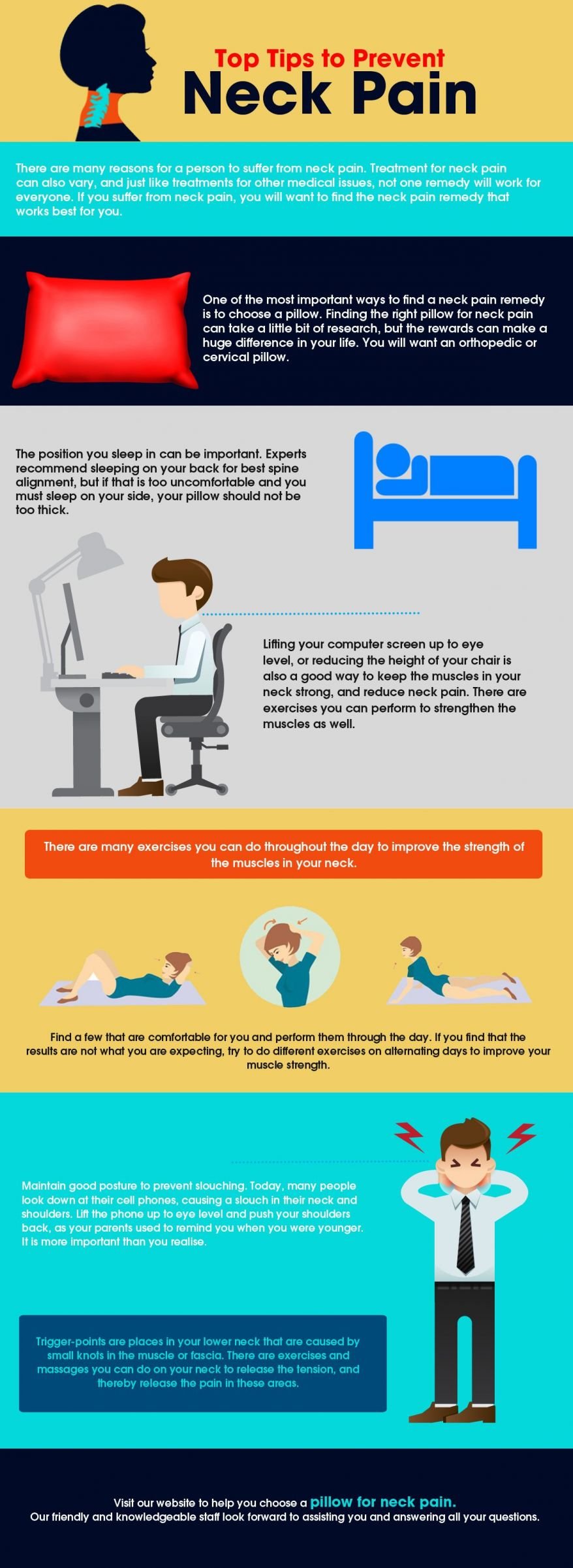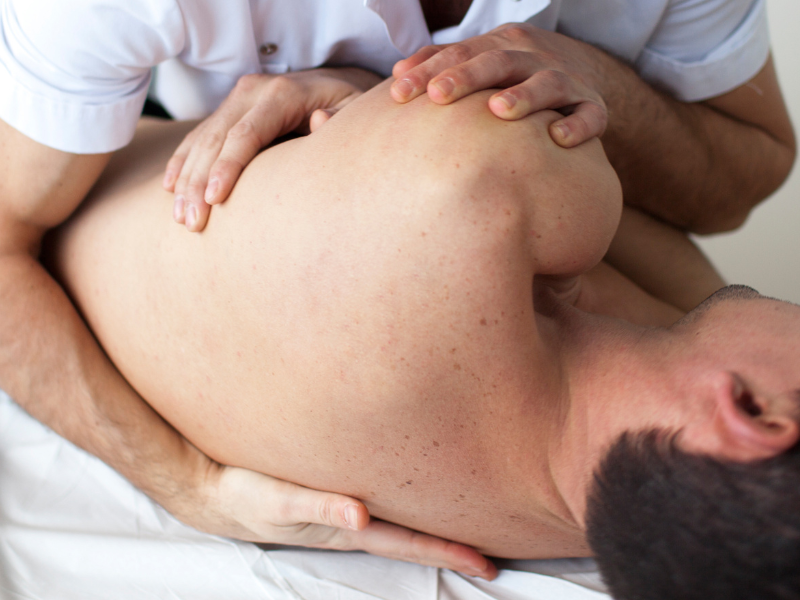There are many reasons for a person to suffer from neck pain.
This can range from a motor vehicle accident that caused a cervical strain, to a cervical herniated disc or cervical stenosis.
Treatment for neck pain can also vary, and just like treatments for other medical issues, not one remedy will work for everyone. If you suffer from neck pain, you will want to find the neck pain remedy that works best for you.
One of the most important ways to find a neck pain remedy is to choose a pillow. Finding the right pillow for neck pain can take a little bit of research, but the rewards can make a huge difference in your life. You will want an orthopaedic or cervical pillow. These are the same, but companies often call them different names. These pillows are contoured to provide support for the area under your neck and head and will keep your neck and spine in alignment.
The position you sleep in can be important.
Experts recommend sleeping on your back for the best spine alignment, but if that is too uncomfortable and you must sleep on your side, your pillow should not be too thick.
Lifting your computer screen up to eye level, or reducing the height of your chair is also a good way to keep the muscles in your neck strong, and reduce neck pain. There are exercises you can perform to strengthen the muscles as well.
Instead of placing your telephone on your shoulder and tilting your head to hold it in place with your ear, try using a headset at work, or Bluetooth for your cell phone. This position places unnecessary strain on your neck muscles.
As mentioned previously, there are many exercises you can do throughout the day to improve the strength of the muscles in your neck. Find a few that are comfortable for you and perform them throughout the day. If you find that the results are not what you are expecting, try to do different exercises on alternating days to improve your muscle strength.
Staying hydrated is also important.
The space between the vertebrae of your back is called discs and they are mostly made of water. Drinking water throughout the day keeps your discs healthy, as well as the many other health benefits you can receive from staying hydrated.
Distribute the weight you carry on a daily basis evenly. Do not keep a purse on only one side. Try using an over-the-shoulder bag to distribute the weight. Change sides frequently so that your shoulder gets a rest. Switch hands you carry your briefcase in often as well. Reduce the amount in your purse or briefcase as well. Do not care about unnecessary items.
Maintain good posture to prevent slouching.
Today, many people look down at their cell phones, causing a slouch in their neck and shoulders. Lift the phone up to eye level and push your shoulders back, as your parents used to remind you when you were younger. It is more important than you realise.
Trigger points are places in your lower neck that are caused by small knots in the muscle or fascia. There are exercises and massages you can do on your neck to release the tension, and thereby release the pain in these areas.
Practice safe driving to prevent whiplash from accidents. We can’t account for other drivers, so make sure to choose a vehicle that has a head restraint that has a high rating.
Visit our website to help you choose a pillow for neck pain. Our friendly and knowledgeable staff look forward to assisting you and answering all your questions. Check out The Physiotherapy Clinics website for great resources.
If your neck pain persists, we recommend you go to your physician or chiropractor's practice for a neck pain assessment. Your doctor will determine if your neck pain is the result of poor posture or other spinal cord or nerve problems. There are physical therapies, neck supports or muscle relaxants that can indicate to help you ease your discomfort and prevent the pain worsen.
Do you want to learn more? Read our Frequently Asked Questions for...
Yes, massage can significantly contribute to better sleep quality. Massage therapy promotes relaxation by reducing stress, anxiety, and muscle tension, which are common obstacles to a peaceful night's sleep. Techniques like acupressure, Swedish massage, and deep tissue massage encourage relaxation and improve blood circulation, preparing the body for rest. By easing physical discomfort and promoting a sense of calm, massage can help create an optimal sleep environment, allowing you to enjoy more restful and rejuvenating sleep.
 0
0 0
0It is recommended to stop drinking alcohol for at least a few hours before going to bed. Alcohol can disrupt your sleep patterns and affect the quality of your rest. It can make you feel drowsy initially, but as it metabolizes in your body, it can lead to fragmented and restless sleep. Additionally, alcohol can increase the likelihood of snoring and sleep apnea, which further disrupts your sleep. Therefore, it is best to avoid consuming alcohol close to bedtime to ensure a more restful and rejuvenating sleep.
On the other hand, it is also advisable to limit your caffeine intake before sleep. Caffeine is a stimulant that can interfere with your ability to fall asleep and stay asleep. It can take several hours for the effects of caffeine to wear off, so it is recommended to avoid consuming caffeinated beverages like coffee, tea, or energy drinks at least four to six hours before bedtime. By doing so, you can give your body enough time to process and eliminate the caffeine, allowing you to have a better chance of falling asleep and experiencing a more restorative sleep throughout the night.
 0
0 0
0It is generally recommended to stop consuming caffeine at least 6 hours before bedtime. Caffeine is a stimulant that can interfere with your sleep quality and make it harder for you to fall asleep. By allowing a sufficient gap between your last caffeine intake and bedtime, you give your body enough time to metabolize and eliminate the caffeine from your system, reducing its impact on your sleep.
However, it's important to note that the exact time frame may vary from person to person. Some individuals are more sensitive to caffeine and may need to stop consuming it even earlier in the day to avoid sleep disturbances. Additionally, factors such as age, metabolism, and overall health can influence how long caffeine stays in your system. If you find that caffeine affects your sleep, it's best to experiment with different cut-off times to determine what works best for you. Remember, a good night's sleep is essential for your overall well-being, so it's worth considering limiting your caffeine intake before sleep.
 0
0 0
0The time it takes for food to digest before sleep can vary depending on the type and quantity of food consumed. Generally, it is recommended to allow at least two to three hours for digestion before going to bed. This allows your body enough time to break down and absorb the nutrients from the food, preventing discomfort and promoting better sleep quality.
Eating a heavy meal or consuming foods that are high in fat, protein, or spice can take longer to digest. These types of foods require more effort from your digestive system, which can lead to indigestion or acid reflux if you lie down too soon after eating. On the other hand, lighter meals that are rich in fiber, such as fruits, vegetables, and whole grains, tend to digest more quickly.
To ensure a good night's sleep, it's advisable to have your last meal or snack at least two to three hours before bedtime. This allows your body enough time to process the food and reduces the risk of discomfort or disrupted sleep. Additionally, choosing lighter, easily digestible foods can help promote a more restful night's sleep. Remember to listen to your body and adjust your eating habits accordingly to find what works best for you.
 0
0 0
0It is recommended to change your bed sheets at least once every two weeks. Bed sheets accumulate dirt, sweat, and dead skin cells over time, which can create an unhygienic sleeping environment. Regularly changing your bed sheets helps maintain cleanliness and freshness, promoting better sleep and overall well-being. However, if you have allergies, sensitive skin, or certain health conditions, it may be beneficial to change your bed sheets more frequently, such as once a week, to minimize potential irritants and allergens.
In addition to regular washing, it is important to handle bed sheets with care. Follow the manufacturer's instructions for washing and drying to maintain their quality and longevity. Consider having a spare set of bed sheets on hand, so you can easily swap them out while the others are being laundered. By keeping your bed sheets clean and fresh, you can create a comfortable and inviting sleeping environment for a restful night's sleep.
 0
0 0
0








